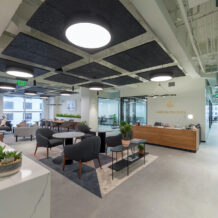The past several weeks have drastically altered our global economy and left many industries wondering “What’s next?”. Both Employers and CRE professionals are asking: “What can be designed into buildings to make them healthier and more attractive to our team?”. As design professionals, there is the opportunity to create new standards within Workplace Design, and by using the foundation established by LEED and WELL Certified buildings, we have identified some key principles and trends which can be adopted immediately.
1. Building Systems, Automation, and Technology: Engineers, along with Architects, will be challenged to redesign mechanical systems in large buildings to minimize and limit the movement of airborne contaminants. The ability to shut off, restrict, or redirect airflow, as well as provide HEPA filtration and UV light sterilization, will become more standard. High Touch areas such as doors, lighting controls, elevators, and signage will need to be re-evaluated as client demand for automation and technology, such as retinal scanners for security or blue tooth connectivity, become more common.
2. Materials: A health-first approach to material selection will figure more prominently in the development and construction of interior spaces. Metals such as copper and silver have natural anti-microbial properties which can be fused into surfaces, hardware and woven into fabrics. While these products have been utilized more predominantly in Healthcare over the last decade, Workplace Design will prioritize and incorporate these germ-resistant products into new spaces, particularly high-traffic areas. The rise in demand will likely reduce the cost of entry for these products and help to mainstream them as fundamental design solutions.
3. Space Planning and Design: In recent years, experiential design has had extensive influence across all industries. With a wellness approach in mind, designers will need to be more acutely attuned to the psychological needs of users. Integrating automation with human interaction in strategic areas, to help users feel more comfortable with flow and movement in open spaces. In recent years there has been a push for smaller work areas and larger collaborative areas. However, as companies embrace social distancing the trends in work areas will change. Companies will seek to develop smaller remote and larger collaborative areas on a wider scale, as well as large aisle ways, to embrace new social norms.
4. Remote Work and Office Policies: Many companies were required to quickly adapt and accommodate a remote workforce, an experience which will have a lasting impact on how companies and teams operate in the future. The CRE Market, as well as design professionals, will need to re-evaluate standard programing and square footage requirements to accommodate a new style of work. Large corporate campuses may find that technology paired with smaller regional offices allow for greater collaboration and connectivity, while also extending their talent pool. Office environments will need both individual and group areas designed specifically around video conferencing, quality, and acoustics, to support the increase in frequency of teleconferencing. Developing and encouraging an office culture which allows people choice on how and where they work will allow companies to ease their teams into the new normal.
Collaboration between organizations and markets, complimented by architectural and engineering professionals, will drive innovation in designing healthy buildings. With leading Healthcare and Workplace practices, Baker Barrios continues to be a dedicated team member in this conversation.





